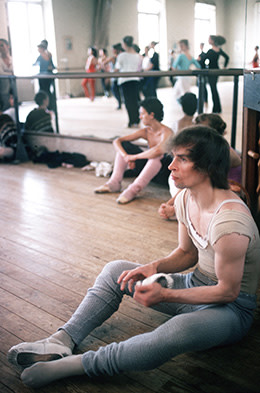Rudolf Nureyev: from small steps to one giant leap
Simply sign up to the Life & Arts myFT Digest -- delivered directly to your inbox.
You might think that the bones of the Nureyev legend had been picked clean by now, but ballet fans should stand by for another wave of films, starting next Saturday with the BBC’s dramatised documentary Rudolf Nureyev — Dance to Freedom. The film is one of a clutch of broadcasts rounding off the BBC’s Year of Song and Dance, which includes Darcey Bussell on the rise of the male ballet dancer and Alan Yentob on the making of Carlos Acosta’s critically reviled Carmen.
Dance to Freedom steals a march on David and Jacqui Morris’s documentary Nureyev, scheduled for release in cinemas next year — but there will be a longer wait for another feature-length biopic to be directed by Ralph Fiennes that doesn’t begin shooting until late 2016. Fiennes’s film is to be scripted by David Hare, who is apparently ducking a whole-life treatment in favour of a Telling Episode (as yet unspecified). There are plenty of these to choose from: Nureyev’s partnership with Margot Fonteyn, his work on Ken Russell’s Valentino (1977), his love affair with Danish dancer Erik Bruhn or, heaven forbid, the last desperate UK tour undertaken two years before his death from Aids in 1993, during which one disappointed theatregoer sued for a refund. Let’s hope Hare doesn’t pick the weeks leading up to Nureyev’s sensational defection at Le Bourget airport in Paris on June 16 1961, as this is the main meat of BBC2’s Dance to Freedom.
Just as his Kirov colleagues were about to board the flight for the London leg of the company’s first-ever tour of western Europe, the 23-year-old star was told he had to fly home for a Kremlin gala. He smelled a rat, realising that his fraternising with westerners in Paris was about to be punished: no London debut, no international celebrity and every possibility of internal exile in his home city of Ufa. “I am a dead man,” he said.
Accounts of what followed vary considerably. Some saw fisticuffs and a paper knife, others swore blind that the whole thing occurred on the airport tarmac. Nureyev himself (not an especially reliable memoirist) remembered it as “six steps exactly . . . no jumping, no running, no screaming, no hysteria”. Yet the “leap to freedom” tag caught the public imagination. Richard Curson Smith’s docudrama offers two versions of the big moment: one is a melange of various witness statements (complete with paper knife); the second is a slow-mo fantasy sequence in which the desperate young dancer pirouettes clear of his KGB minders and literally jetés into the arms of French airport police.

Most of the film’s talking heads — Pierre Lacotte, Ghislaine Thesmar, Sergei Vikulov — offer retreads of the testimony they gave for John Bridcut’s handsome 2007 documentary Nureyev: From Russia with Love. Curson Smith adds expert analysis from the FT’s own Laura Cappelle (dance consultant for the film) and includes a rare audio interview with Clara Saint, the beautiful, well-connected and extremely resourceful young socialite who played such a key role in the final moments at Le Bourget. There are also fireside chats with an avuncular pair of ex-KGB men, Arsen Martirosyan and Alexander Mikhailov, both of whom claim that Nureyev’s defection was engineered in order to discredit KGB chief Alexander Shelepin (although this seems a mite far-fetched, given that Shelepin was appointed deputy prime minister the year after the defection).
Previous Nureyev films have mined a rich seam of amateur and professional archive footage but in Dance to Freedom the famous solos are created afresh by Bolshoi star Artem Ovcharenko. With his exotic bone structure and boyish beauty, Ovcharenko is a good physical match and gives polished — almost too polished — accounts of the solos from Le Corsaire, The Sleeping Beauty and Don Quixote. Nureyev, who did not start serious ballet training until he was 17, was always the first to admit that he was an uneven technician but there was a plasticity and urgency in his dancing that transcended technique. “He ran on stage like a kamikaze,” remembers Ghislaine Thesmar.

Ovcharenko, with his new “beatnik haircut” (Cecil Beaton’s phrase) joins the dots between the familiar photographs of Nureyev: posing as Narcissus/sitting on his suitcase for his snap-happy friend Tamara Zakrzhevskaya or (still more famously) stripping off for Richard Avedon. The dramatisations are set and dressed with great style — imagine Mad Men in tights — and the washed-out colour treatment helps blur the edges between old and new material.
Even after Nureyev was granted asylum, the KGB stayed on the case, and when he emerged from hiding to guest star with the Marquis de Cuevas Ballet, a group of French communists staged a mini-riot. Coins, fruit and vegetables were thrown but the young dancer powered through his Bluebird solo, oblivious to the catcalls. In the film’s closing moments French ballet critic René Sirvin vividly recalls the scene while we watch Ovcharenko skim tirelessly through the entrechats, slippered feet fluttering over the broken glass. “They did everything possible to unnerve him but he kept going,” smiles Sirvin. “That day he really became free.”
‘Rudolf Nureyev: Dance to Freedom’ will be broadcast on BBC2 on December 19
Photographs: Hulton/Getty; BBC
Comments